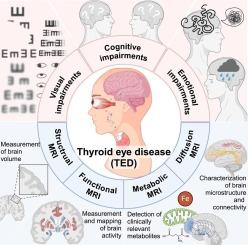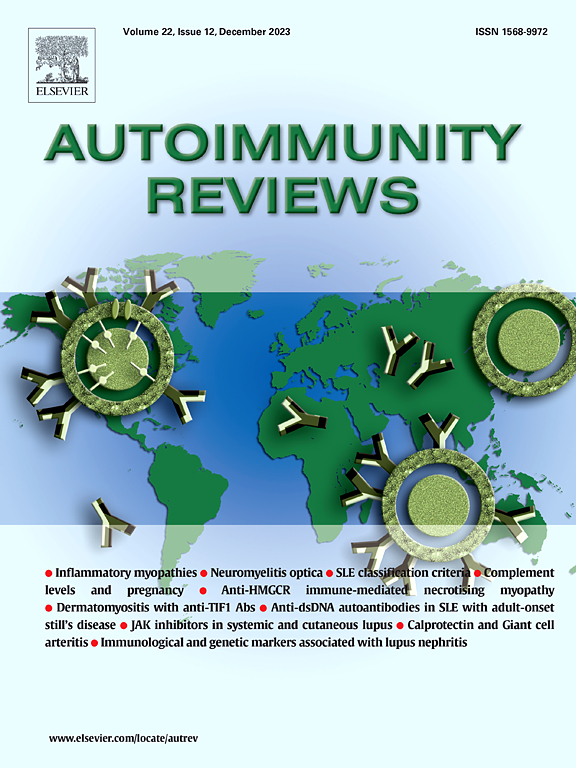Neuroimaging in thyroid eye disease: A systematic review
IF 9.2
1区 医学
Q1 IMMUNOLOGY
引用次数: 0
Abstract
Thyroid eye disease (TED) is an organ-specific autoimmune disease secondary largely to hyperthyroid Graves' disease, which profoundly affects patients' visual function, appearance, and physical and mental well-being. Emerging neuroimaging studies have reported alterations in the brains of patients with TED, suggesting that the impact of this autoimmune disease may extend beyond the orbit. This systematic review aims to consolidate the neuroimaging evidence that describes the brain alterations of TED. We analyzed information from thirty-one related studies involving 1349 TED patients and 710 healthy controls, employing multimodal neuroimaging techniques such as structural magnetic resonance imaging (MRI), functional MRI, diffusion MRI, and metabolic MRI. These studies define the brain alterations in regions associated with vision, cognition, and emotion regulation, such as gray matter volume changes, altered functional connectivity and activity, and microstructural modifications, revealing the neurological impact of TED beyond the orbit. Notably, there was convergence across these studies indicating predominant abnormalities within the occipital and parietal lobes. This review underscores the critical role of advanced neuroimaging techniques in unraveling the complex neuropathological mechanism of TED, laying a foundation for future research and potential therapeutic targets.

甲状腺眼病的神经影像学研究:系统综述
甲状腺眼病(TED)是一种器官特异性自身免疫性疾病,主要继发于甲状腺功能亢进性巴塞杜氏病,严重影响患者的视觉功能、外观和身心健康。新近的神经影像学研究报告称,TED患者的大脑发生了改变,这表明这种自身免疫性疾病的影响可能超出了眼眶。本系统综述旨在整合描述TED脑部改变的神经影像学证据。我们分析了31项相关研究的信息,涉及1349名TED患者和710名健康对照者,这些研究采用了结构磁共振成像(MRI)、功能磁共振成像(MRI)、弥散磁共振成像(MRI)和代谢磁共振成像(MRI)等多模态神经成像技术。这些研究确定了与视觉、认知和情绪调节相关区域的大脑改变,如灰质体积变化、功能连接和活动改变以及微结构改变,揭示了 TED 对眼眶以外的神经系统的影响。值得注意的是,这些研究的共同点是枕叶和顶叶的主要异常。这篇综述强调了先进的神经成像技术在揭示 TED 复杂的神经病理机制中的关键作用,为未来的研究和潜在的治疗目标奠定了基础。
本文章由计算机程序翻译,如有差异,请以英文原文为准。
求助全文
约1分钟内获得全文
求助全文
来源期刊

Autoimmunity reviews
医学-免疫学
CiteScore
24.70
自引率
4.40%
发文量
164
审稿时长
21 days
期刊介绍:
Autoimmunity Reviews is a publication that features up-to-date, structured reviews on various topics in the field of autoimmunity. These reviews are written by renowned experts and include demonstrative illustrations and tables. Each article will have a clear "take-home" message for readers.
The selection of articles is primarily done by the Editors-in-Chief, based on recommendations from the international Editorial Board. The topics covered in the articles span all areas of autoimmunology, aiming to bridge the gap between basic and clinical sciences.
In terms of content, the contributions in basic sciences delve into the pathophysiology and mechanisms of autoimmune disorders, as well as genomics and proteomics. On the other hand, clinical contributions focus on diseases related to autoimmunity, novel therapies, and clinical associations.
Autoimmunity Reviews is internationally recognized, and its articles are indexed and abstracted in prestigious databases such as PubMed/Medline, Science Citation Index Expanded, Biosciences Information Services, and Chemical Abstracts.
 求助内容:
求助内容: 应助结果提醒方式:
应助结果提醒方式:


